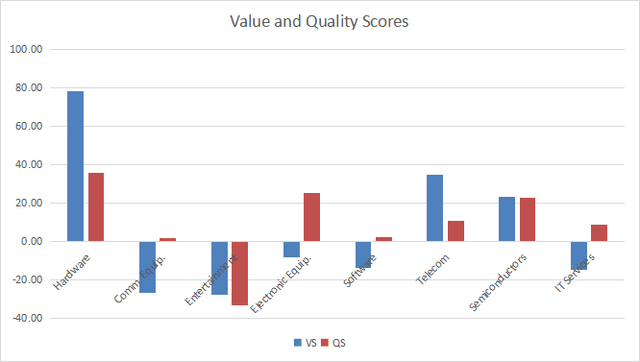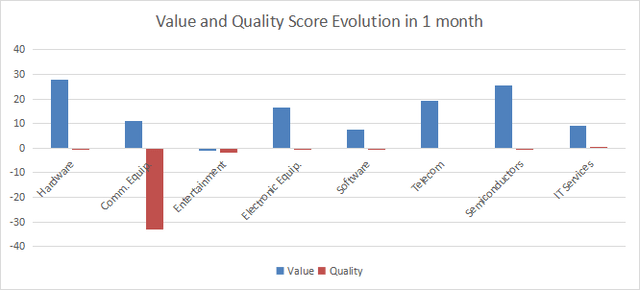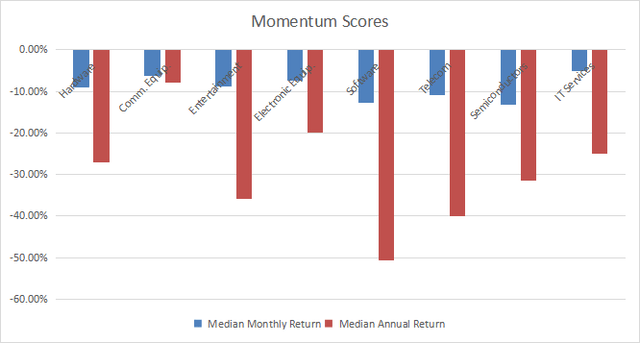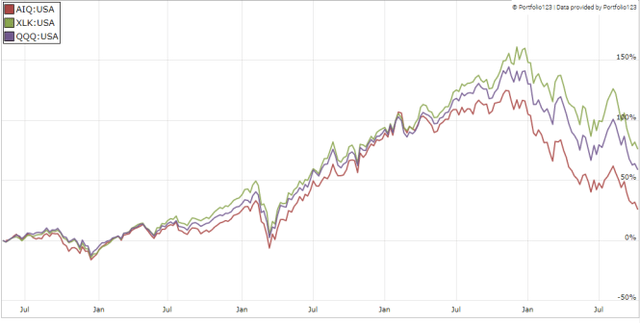Just_Super/E+ via Getty Images
This monthly article series shows a dashboard with aggregate industry metrics in technology and communication services. It may also serve as a top-down analysis of technology ETFs, whose largest holdings are used to calculate these metrics.
Shortcut
The next two paragraphs in italic describe the dashboard methodology. They are necessary for new readers to understand the metrics. If you are used to this series or if you are short of time, you can skip them and go to the charts.
Base Metrics
I calculate the median value of five fundamental ratios for each industry: Earnings Yield (“EY”), Sales Yield (“SY”), Free Cash Flow Yield (“FY”), Return on Equity (“ROE”), Gross Margin (“GM”). The reference universe includes large companies in the U.S. stock market. The five base metrics are calculated on trailing 12 months. For all of them, higher is better. EY, SY and FY are medians of the inverse of Price/Earnings, Price/Sales and Price/Free Cash Flow. They are better for statistical studies than price-to-something ratios, which are unusable or non-available when the “something” is close to zero or negative (for example, companies with negative earnings). I also look at two momentum metrics for each group: the median monthly return (RetM) and the median annual return (RetY).
I prefer medians to averages because a median splits a set in a good half and a bad half. A capital-weighted average is skewed by extreme values and the largest companies. My metrics are designed for stock-picking rather than index investing.
Value and Quality Scores
I calculate historical baselines for all metrics. They are noted respectively EYh, SYh, FYh, ROEh, GMh, and they are calculated as the averages on a look-back period of 11 years. For example, the value of EYh for hardware in the table below is the 11-year average of the median Earnings Yield in hardware companies.
The Value Score (“VS”) is defined as the average difference in % between the three valuation ratios (EY, SY, FY) and their baselines (EYh, SYh, FYh). The same way, the Quality Score (“QS”) is the average difference between the two quality ratios (ROE, GM) and their baselines (ROEh, GMh).
The scores are in percentage points. VS may be interpreted as the percentage of undervaluation or overvaluation relative to the baseline (positive is good, negative is bad). This interpretation must be taken with caution: the baseline is an arbitrary reference, not a supposed fair value. The formula assumes that the three valuation metrics are of equal importance.
Current data
The next table shows the metrics and scores as of last week’s closing. Columns stand for all the data named and defined above.
|
VS |
QS |
EY |
SY |
FY |
ROE |
GM |
EYh |
SYh |
FYh |
ROEh |
GMh |
RetM |
RetY |
|
|
Hardware |
78.31 |
36.05 |
0.0824 |
1.7081 |
0.0502 |
13.08 |
39.41 |
0.0361 |
0.9301 |
0.0408 |
7.36 |
41.78 |
-8.99% |
-27.02% |
|
Comm. Equip. |
-26.60 |
1.81 |
0.0324 |
0.2021 |
0.0184 |
17.99 |
56.49 |
0.0314 |
0.2789 |
0.0413 |
15.64 |
63.77 |
-6.28% |
-7.96% |
|
Entertainment |
-27.88 |
-33.28 |
0.0155 |
0.6183 |
0.0172 |
7.14 |
41.68 |
0.0494 |
0.4414 |
0.0383 |
17.23 |
45.32 |
-8.76% |
-35.94% |
|
Electronic Equip. |
-8.05 |
25.27 |
0.0473 |
0.7317 |
0.0308 |
18.31 |
38.75 |
0.0434 |
0.8141 |
0.0400 |
12.94 |
35.56 |
-7.43% |
-19.87% |
|
Software |
-13.75 |
2.52 |
0.0269 |
0.1432 |
0.0291 |
19.20 |
83.03 |
0.0271 |
0.1749 |
0.0375 |
17.68 |
86.07 |
-12.77% |
-50.54% |
|
Telecom |
34.90 |
10.94 |
0.1020 |
0.9033 |
0.0171 |
14.65 |
57.47 |
0.0502 |
0.6504 |
0.0273 |
11.83 |
58.63 |
-10.83% |
-40.06% |
|
Semiconductors |
23.55 |
22.64 |
0.0670 |
0.2880 |
0.0398 |
34.20 |
62.57 |
0.0467 |
0.2489 |
0.0357 |
23.63 |
62.21 |
-13.25% |
-31.40% |
|
IT Services |
-14.48 |
8.73 |
0.0407 |
0.2471 |
0.0255 |
32.48 |
49.98 |
0.0387 |
0.3324 |
0.0331 |
25.48 |
55.54 |
-5.17% |
-24.88% |
Value And Quality chart
The next chart plots the Value and Quality Scores by industry (higher is better).
Value and quality in technology (Chart: author; data: Portfolio123)
Evolution since last month
Due to price action, the value score has improved in all tech and communication industries except entertainment.
Variations in value and quality (Chart: author; data: Portfolio123)
Momentum
The next chart plots momentum data.
Momentum in technology (Chart: author; data: Portfolio123)
Interpretation
Hardware is the tech industry with the best value and quality scores. Telecommunications and semiconductors also are undervalued relative to 11-year averages, and they are above their baseline in quality. Other subsectors are overvalued by 8% to 28% regarding my metrics. Entertainment is the less attractive one, with both value and quality scores far below the baseline.
Focus on AIQ
The Global X Artificial Intelligence & Technology ETF (NASDAQ:AIQ) has been tracking the Indxx Artificial Intelligence & Big Data Index since 05/11/2018. It has a total expense ratio of 0.68%, which is significantly more expensive than broader sector index ETFs like XLK and VGT (both at 0.10%).
As described by Global X ETFs, eligible stocks are in two categories:
- Artificial intelligence developers and artificial intelligence-as-a-service providers.
- Artificial intelligence hardware and quantum computing.
Eligible stocks are screened for some criteria on capitalization, liquidity and country. Then, the top 60 companies from the first category and the top 25 companies from the second category form the underlying index.
As of writing, the fund holds 82 stocks, mostly in the U.S. (65.6% of asset value) and other developed countries. However, China weighs 10.3%, which represents a direct exposure to geopolitical and regulatory risks. About 60% of asset value is in the IT sector, followed by communication services (about 15%), consumer discretionary (13%) and industrials (10%). There are a few minor holdings in financials and healthcare.
The next table shows the top 10 holdings with basic valuation and growth metrics. Their aggregate weight is 32.8%.
|
Ticker |
Name |
Weight% |
EPS growth %TTM |
P/E TTM |
P/E fwd |
Yield% |
|
Netflix, Inc. |
3.79 |
16.59 |
20.45 |
22.78 |
0 |
|
|
International Business Machines Corp. |
3.48 |
3.84 |
19.51 |
12.95 |
5.50 |
|
|
Cisco Systems, Inc. |
3.32 |
12.84 |
14.26 |
11.41 |
3.78 |
|
|
Apple, Inc. |
3.28 |
18.52 |
22.87 |
22.70 |
0.66 |
|
|
Accenture PLC |
3.23 |
17.01 |
23.59 |
22.11 |
1.77 |
|
|
Microsoft Corp. |
3.18 |
19.73 |
23.70 |
22.68 |
1.19 |
|
|
Oracle Corp. |
3.18 |
-55.28 |
30.54 |
13.05 |
1.99 |
|
|
Amazon.com, Inc. |
3.16 |
-61.05 |
95.67 |
4515.31 |
0 |
|
|
Alphabet, Inc. |
3.11 |
16.52 |
17.97 |
18.72 |
0 |
|
|
005930 KS |
Samsung Electronics |
3.07 |
Data calculated with Portfolio123
Since inception in May 2018, AIQ has been lagging behind the technology benchmark XLK and the Nasdaq 100 (QQQ).
AIQ vs XLK and QQQ since inception. (Portfolio123)
In summary, AIQ is a well-designed fund investing in artificial intelligence software and hardware. It is diversified in over 80 stocks, none of them weighs more than 4%, so risks related to individual companies are moderate. However, it has a 10% exposure to risks related to China. Price history is too short to assess the strategy, we can just say it has underperformed the IT sector and the Nasdaq 100 in the last 4 years.
Dashboard List
I use the first table to calculate value and quality scores. It may also be used in a stock-picking process to check how companies stand among their peers. For example, the EY column tells us that a hardware company with an earnings yield above 0.0824 (or price/earnings below 12.14) is in the better half of the industry regarding this metric. A Dashboard List is sent every month to Quantitative Risk & Value subscribers with the most profitable companies standing in the better half among their peers regarding the three valuation metrics at the same time. The list below was sent to subscribers several weeks ago based on data available at that time.
|
Kulicke and Soffa Industries, Inc. |
|
|
Thryv Holdings, Inc. |
|
|
Meta Platforms, Inc. |
|
|
Ziff Davis, Inc. |
|
|
ON Semiconductor Corp. |
|
|
Alpha & Omega Semiconductor Ltd. |
It is a rotating list with a statistical bias toward excess returns on the long term, not the result of an analysis of each stock.


Be the first to comment